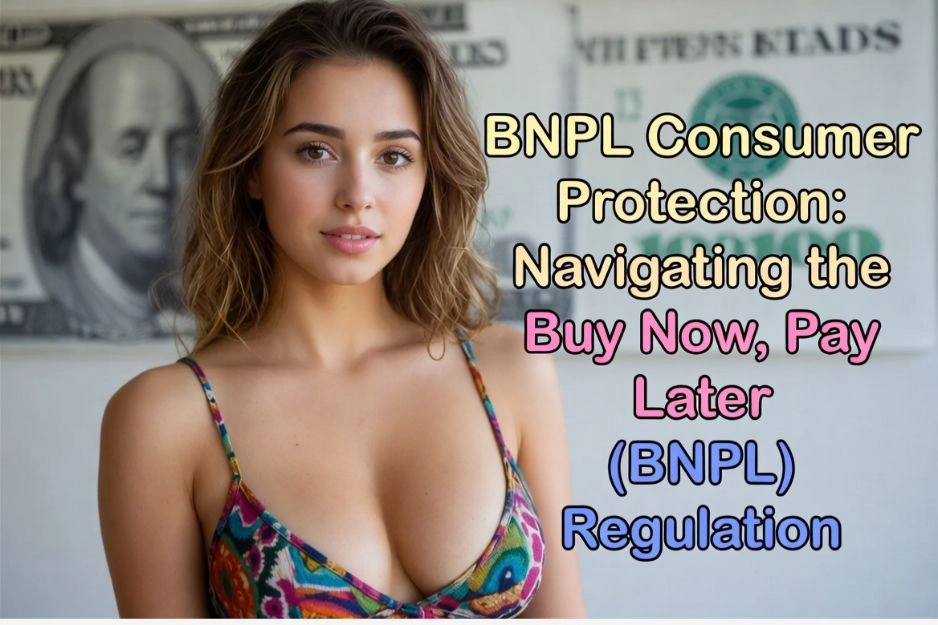BNPL Consumer Protection: The New Trend in Shopping
In recent years, the shopping landscape has been transformed by the emergence of Buy Now, Pay Later (BNPL) services, particularly resonating with millennials and Generation Z. These payment options have gained popularity due to their convenience and the enticing promise of immediate gratification. Much like ordering that decadent dessert off a restaurant menu, BNPL appeals to the urge to indulge without the immediate consequences of payment, leading many consumers to explore this novel financial tool.
As BNPL providers continue to flourish, the trend has raised critical questions about financial responsibility and long-term implications. The inherent appeal lies in the flexibility of making purchases without the burden of upfront costs. However, one might wonder whether such an enticing option comes with hidden repercussions for personal financial health, much like a dessert loaded with calories hidden beneath a seemingly harmless facade. This narrative invites us to delve deeper into the world of BNPL and understand its implications, including the necessity for robust consumer protection measures.
Regulatory scrutiny surrounding BNPL is increasing, as stakeholders acknowledge the need for transparency and protection in this rapidly evolving market. Essential topics arise, such as affordability checks that ensure consumers can manage payments without falling into a debt cycle and the implementation of late fee caps to prevent exorbitant charges. Additionally, the dialogue around credit reporting and the underwriting standards of BNPL providers becomes crucial for safeguarding the consumers’ financial health.
As we navigate this issue, we must also juxtapose BNPL against traditional credit cards, highlighting the pros and cons of each method. While BNPL offers an attractive alternative, the importance of understanding its pitfalls will be vital for consumers seeking a balanced approach to their financial future. This blog post aims to unravel the complexities of BNPL regulation, focusing on consumer protection to enable responsible usage and smart financial decisions.
Understanding BNPL: How It Works

Buy Now, Pay Later (BNPL) services are reshaping the way consumers approach payments for a variety of purchases. At its core, BNPL enables consumers to acquire products immediately while paying for them in installments over a specified period. This payment method is particularly beneficial for those who may not have immediate access to cash or prefer to spread the cost of a purchase over time.
The typical process begins when a consumer selects goods at a participating merchant’s checkout, say a new gaming console or a high-end coffee machine. During the checkout process, the consumer is presented with the option to split their total purchase price into manageable installments. Upon choosing BNPL, the consumer usually fills out a short application, allowing the BNPL provider to conduct affordability checks to assess the customer’s financial stability and ability to meet installment payments.
The BNPL provider then reviews the consumer’s qualifications and usually makes a rapid decision. If approved, the consumer can finalize their purchase, receiving their item right away. The BNPL provider fronts the total cost to the merchant upfront, relieving the merchant of financial risk while providing the consumer with immediate access to their desired product.

Repayment terms can vary, typically ranging from a few weeks to several months, during which the consumer will make scheduled payments. The ease of use and straightforward terms appeal to many consumers, especially when compared to traditional credit cards. However, it’s crucial to understand potential pitfalls, such as late fee caps and the possibility of entering a debt cycle if payments are missed. Regulatory scrutiny surrounding BNPL services is increasing, addressing issues such as credit reporting and transparency related to Annual Percentage Rates (APR). A growing number of best BNPL providers are now adhering to higher underwriting standards and prioritizing consumer protection through financial health monitoring and alternative credit scoring methods.
The Rise of Regulation: Why It’s Happening
The landscape of financial services is ever-evolving, and the emergence of Buy Now, Pay Later (BNPL) schemes has prompted a wave of regulatory scrutiny. Like overprotective parents keeping a watchful eye on their child’s spending habits, regulatory bodies are concerned about how these services may influence consumer behavior. With many consumers gravitating towards BNPL as an appealing alternative to traditional credit cards, the potential for debt accumulation has raised alarms.
One of the key issues fueling this rise in regulation is the lack of transparency accompanying many BNPL products. Unlike credit cards, which typically disclose their Annual Percentage Rate (APR) and associated fees, many BNPL providers have been less forthcoming. This opacity can lead consumers to misinterpret the true cost of borrowing, ultimately jeopardizing their financial health. The absence of affordability checks, which are critical for determining whether a consumer can manage additional debt, might contribute to a cycle of debt that spirals out of control.
Furthermore, as financial health monitoring becomes increasingly important, regulatory scrutiny seeks to ensure that consumers are not only protected from misleading practices but are also equipped with alternative credit scoring methods. Understanding how BNPL differs from credit cards—especially in terms of pros and cons—is essential for consumers navigating these choices.
Additional regulations could potentially include late fee caps and improved credit reporting standards that foster responsible borrowing. The primary aim is to help consumers avoid being ensnared in a debt cycle, thereby protecting their financial future. It is clear that regulatory bodies are not merely acting as a hindrance but rather as guardians of consumer interests, fostering an environment where responsible borrowing is encouraged and risky behavior is mitigated.
Consumer Protections: What to Look For
As the popularity of Buy Now, Pay Later (BNPL) options continues to rise, so too does the need for robust consumer protection measures. These safeguards are essential to ensure that consumers can benefit from BNPL services without being ensnared in a cycle of debt that can lead to financial distress. One critical element of BNPL regulation is the implementation of affordability checks. These checks evaluate a consumer’s ability to repay their BNPL purchases, helping to deter reckless spending that may lead to overwhelming debt. After all, nobody wants to resemble a debt-ridden shopping zombie, stumbling through life without awareness of their financial situation.
Another fundamental consumer protection in the realm of BNPL is the establishment of late fee caps. With fees often spiraling out of control, these caps ensure that consumers are not penalized excessively if they fail to make a payment on time. This measure can significantly alleviate the stress associated with missed payments and mitigate the risk of falling deeper into the debt trap. When consumers engage in BNPL plans, knowing they are protected from exorbitant fees can transform their shopping experience into a more positive one.
Moreover, transparent APR disclosures are a crucial aspect of the consumer protection framework. Clear visibility regarding the annual percentage rate allows consumers to compare various BNPL offers, much like assessing the ‘best BNPL providers’ in the market. This level of transparency can empower consumers to make informed choices, balancing the pros and cons of BNPL versus credit cards effectively. Additionally, regulations surrounding credit reporting must also be considered, as they determine how BNPL usage impacts a consumer’s credit score, thereby influencing their overall financial health.
Ultimately, these consumer protection measures—affordability checks, late fee caps, and transparent APR disclosures—are instrumental in fostering responsible borrowing behaviors. By addressing these key areas, potential pitfalls can be avoided, and consumers can navigate the BNPL landscape safely, thereby protecting their financial well-being.
BNPL vs. Credit Cards: Pros and Cons

When it comes to making purchases, consumers increasingly find themselves weighing the merits of Buy Now, Pay Later (BNPL) services against traditional credit cards. Both methods have distinct advantages and disadvantages that can influence consumer choice, educated primarily through affordability checks and regulatory scrutiny. Understanding these elements is crucial for making informed financial decisions.
On the one hand, BNPL services often provide immediate gratification without the burden of high-interest rates typically associated with credit cards. For instance, think of a time when a friend rushed to buy the latest gadget because it was on sale, opting for a BNPL plan instead of whipping out a credit card. The friend savored the joy of ownership without the immediate loss in funds, allowing for deferred payment. With BNPL, the payment timeline is clearer, promoting transparency and APR transparency; consumers know exactly what they owe and when they owe it.
However, BNPL consumer protection issues can surface if users fail to understand the fine print, potentially leading them into a debt cycle. Late fee caps vary by provider, leading to confusion and sometimes resulting in higher fees than anticipated. In contrast, credit cards often carry more flexible payment options but can lead to unexpected charges if the balance becomes too high. Consider a moment when someone impulsively bought shoes via a credit card without realizing their existing balance—surprise, debt!
Moreover, BNPL services frequently lack the robust credit reporting and underwriting standards that traditional credit cards offer. This can be advantageous for those with limited credit history. Yet, without financial health monitoring, consumers might overlook their cumulative spending, risking overspending in the process. Ultimately, each option has its merits and caveats, and the decision often hinges on individual financial situations and spending habits. The key lies in assessing one’s needs thoughtfully while being wary of the potential pitfalls.
Current Trends and Best BNPL Providers

The landscape of Buy Now, Pay Later (BNPL) services has significantly evolved in recent years, driven by both consumer demand and increasing regulatory scrutiny. As the popularity of BNPL options grows, consumers are becoming more aware of the protections that these services should offer. With a focus on affordability checks and APR transparency, regulations aim to safeguard consumers from falling into a debt cycle and ensure informed borrowing decisions.
Among the best BNPL providers currently on the market, companies like Afterpay, Klarna, and Affirm stand out. They have actively adapted to the regulatory environment by enhancing their consumer protection measures, such as implementing late fee caps and improving credit reporting practices. These changes not only benefit users but also reflect a growing emphasis on financial health monitoring and responsible lending within the industry.
Selecting a BNPL provider can sometimes feel like watching a reality show competition titled “Who’s the Best?” Each service brings unique features and benefits to the table, making it essential for consumers to evaluate their options carefully. Some providers offer flexible repayment plans and user-friendly mobile apps, while others focus on transparent underwriting standards and alternative credit scoring. The choice ultimately depends on individual preferences and financial circumstances.
As consumers navigate the BNPL landscape, it is crucial to understand the pros and cons of BNPL versus credit cards. While BNPL can offer more straightforward payment structures without the burden of interest rates, credit cards may provide additional rewards and benefits. By comparing these options and staying informed about how BNPL is regulated, consumers can make well-informed choices that align with their financial goals.
Future of BNPL Regulations: What Lies Ahead?
The Buy Now, Pay Later (BNPL) sector has seen exponential growth in recent years, becoming a popular alternative to traditional credit cards. As this innovative payment method continues to gain traction, related regulations are evolving rapidly, aiming to foster consumer protection and financial stability. Current trends indicate that future regulations will increasingly focus on affordability checks to ensure that consumers are not overextending their financial limits when using BNPL services.
One notable development to expect is the tightening of underwriting standards. Regulators are likely to mandate more rigorous evaluations of a consumer’s financial health, which may include enhanced scrutiny of credit histories and alternative credit scoring methodologies. By implementing these measures, the objective is to prevent consumers from entering a debt cycle, ensuring that they can responsibly manage their repayments without the fear of incurring heavy late fees or falling into unfair credit pitfalls.
Another significant area of change might surround the issue of transparency. Consumers will demand greater clarity around the annual percentage rates (APR) associated with BNPL services. As competition among the best BNPL providers intensifies, companies will need to demonstrate their commitment to transparent practices and possible caps on late fees, which could alleviate financial distress for users.
The regulatory landscape will likely be shaped by continuous feedback and engagement between industry stakeholders and policymakers. This evolution resembles a financial version of a soap opera—complete with plot twists, stakeholder drama, and the ever-present tension between innovation and regulation. As we anticipate these developments, the overarching goal will remain: to enhance consumer protection while enabling access to flexible payment options. The narrative will ultimately unfold toward achieving a balance that ensures consumers can enjoy the benefits of BNPL without compromising their financial well-being.
Tips for Responsible BNPL Usage
The Buy Now, Pay Later (BNPL) option can be enticing, but it is crucial to approach it with caution and responsibility. First and foremost, assess your financial health before deciding to engage in any BNPL transactions. This means taking a good look at your income, expenses, and existing debts. Ask yourself: can I afford this cute sweater without sinking deeper into the abyss of the debt cycle? Remember, a fashionable item should not jeopardize your credit score!
Next, familiarize yourself with the terms and conditions of the BNPL provider. Understanding how BNPL is regulated is essential, especially concerning affordability checks, late fee caps, and credit reporting practices. Check if the provider has transparent APR policies—this can help you avoid unpleasant surprises. You would not want to inappropriately believe you’re saving money when, in reality, the interest rates might be sky-high! Pay attention to the underwriting standards to prevent the chance of taking on more than you can handle.
Another useful tip is to establish a budget that allows you to track your BNPL purchases, alongside regular expenses. This will help in maintaining a budget and avoiding impulsive buying that can lead to financial strain. Before you click that ‘Buy Now’ button, consider how you will feel about this purchase a month from now. Is it worth the risk of falling into a debt cycle? Or will it just gather dust in your closet?
Lastly, engage in regular financial health monitoring. It becomes easier over time to keep track of your spending habits, especially with many providers now offering tools that facilitate this. By practicing these responsible BNPL strategies, you can enjoy the benefits without complicating your financial landscape. Embrace these tips, and you will navigate the BNPL waters like a pro!
BNPL Consumer Protection: Join the Conversation
As we conclude our exploration of Buy Now, Pay Later (BNPL) regulation and its implications for consumer protection, it becomes evident that understanding these frameworks is crucial for making informed financial decisions. With the rise of BNPL services, it is essential for consumers to be aware of how these options differ from traditional credit cards. The pros and cons of BNPL — including affordability checks, late fee caps, and credit reporting — play a significant role in safeguarding consumer interests.

Effective regulatory scrutiny helps ensure that the best BNPL providers adhere to stringent underwriting standards and maintain transparency in their annual percentage rates (APR). This vigilance not only promotes debt cycle prevention but also fosters financial health monitoring and alternative credit scoring methods to enhance accessibility for various consumers. By prioritizing consumer protection in BNPL services, we can create a more equitable financial landscape.
Now, here’s a little humor to lighten the mood: picture a shopping cart fully loaded with items you didn’t plan to buy, all the while shouting “Treat Yourself!” as you approach the checkout. Finding out that “treat yourself” comes with hidden fees and potential debt cycles can be quite the awakening! It’s like realizing that the fabulous dress you bought online is actually two sizes too small — not as fabulous as you imagined! This serves as a gentle reminder to engage wisely with BNPL options, ensuring that consumer protection remains top of mind.
We invite you to share your thoughts on BNPL regulations. Have you had experiences with BNPL services that shaped your perspective? What do you think about the current regulatory landscape? Engaging in this conversation is vital, and your insights could help others navigate the complexities of BNPL. Please feel free to comment below and join in on the dialogue!






























